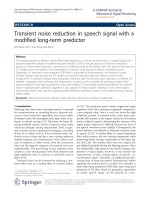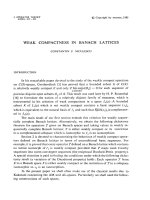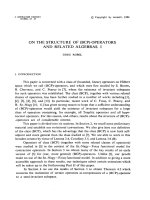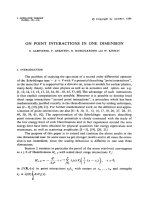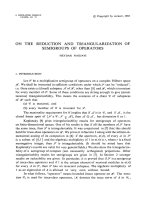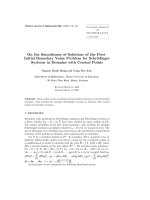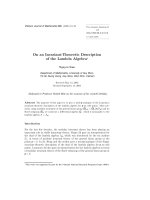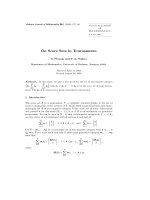Báo cáo toán học: "On regular factors in regular graphs with small radius" ppsx
Bạn đang xem bản rút gọn của tài liệu. Xem và tải ngay bản đầy đủ của tài liệu tại đây (86.26 KB, 7 trang )
On regular factors in regular graphs with small radius
Arne Hoffmann
Lehrstuhl C f¨ur Mathematik
RWTH-Aachen, 52056 Aachen, Germany
Lutz Volkmann
∗
Lehrstuhl II f¨ur Mathematik
RWTH-Aachen, 52056 Aachen, Germany
Submitted: Aug 21, 2001; Accepted: Nov 5, 2003; Published: Jan 2, 2004
MR Subject Classifications: 05C70, 05C35
Abstract
In this note we examine the connection between vertices of high eccentricity and
the existence of k-factors in regular graphs. This leads to new results in the case
that the radius of the graph is small (≤ 3), namely that a d-regular graph G has all
k-factors, for k|V (G)| even and k ≤ d, if it has at most 2d + 2 vertices of eccentricity
> 3. In particular, each regular graph G of diameter ≤ 3 has every k-factor, for
k|V (G)| even and k ≤ d.
1 Introduction
All graphs considered are finite and simple. We use standard graph terminology. For
vertices u, v ∈ V (G)letd(u, v) be the number of edges in a shortest path from u to
v, called the distance between u and v. Let further e(v):=max{d(v, x): x ∈ V (G)}
denote the eccentricity of x. The radius r(G) and the diameter dm(G) of a graph G are
the minimum and maximum eccentricity, respectively. If a graph G is disconnected, then
e(v):=∞ for all vertices v in G.
Thecompletegraphwithn vertices is denoted by K
n
.ForasetS ⊆ V (G)letG[S]
be the subgraph induced by S.Inanr-almost regular graph the degrees of any two
vertices differ by at most r.Forb ≥ a>0 we call a subgraph F of G an [a, b]-factor,
if V (F )=V (G) and the degrees of all vertices in F are between a and b.Wecalla
[k, k]-factor simply a k-factor. If we do not say otherwise, we quietly assume that k<d
if G is a d-regular graph.
Many sufficient conditions for the existence of a k-factor in a regular graph are known
today. Good surveys can be found in Akiyama and Kano [1] as well as Volkmann [8].
As far as we know, none of these conditions have taken the eccentricity of vertices into
∗
corresponding author
the electronic journal of combinatorics 11 (2004), #R7 1
account. It is an easy exercise to show that every regular graph G with dm(G)=1has
a k-factor if k|V (G)| is even. For dm(G) ≥ 2 the case becomes more involved. The main
result of this note is the following theorem, which provides a connection between vertices
x with e(x) > 3 and the existence of a k-factor.
Theorem 1.1 For d ≥ 3 let G be a connected d-regular graph. For an integer 1 ≤ k<d
with k|V (G)| even G has a k-factor if
• d and k are even;
• d is even, k is odd and G has at most (d +1)· min{k +1,d− k +1} vertices of
eccentricity ≥ 4;
• d and k are odd and G has at most 1+(d +2)(k +1) vertices of eccentricity ≥ 4;
• d is odd and k is even and G has at most 1+(d+2)(d−k +1) vertices of eccentricity
≥ 4.
Theorem 1.1 implies the following two results as corollaries.
Theorem 1.2 A connected d-regular graph, d ≥ 2,withatmost2d +2 vertices of eccen-
tricity ≥ 4 has every k-factor for k|V (G)| even.
Theorem 1.3 A connected d-regular graph, d ≥ 2, with diameter ≤ 3 has every k-factor
for k|V (G)| even.
Theorem 1.1 is in the following way best possible: Let d be even and let k be odd with
d ≥ 2k +4. Takek + 1 copies of K
d+1
− uv and a copy of K
d+1
− M,whereM denotes
a matching of cardinality
d−2(k+1)
2
,aswellasavertexx. Connect x to all vertices u, v of
degree d − 1. The resulting graph G is d-regular and has
(k +1)(d − 1) + 2k +3=(d +1)(k +1)+1
vertices of eccentricity 4. It further has no k-factor since Θ
G
({x}, ∅,k)=−2(seeTheo-
rem 2.1). Now let d and k be odd with d ≥ 3k + 6. For an odd integer 0 <p<ddefine
K
d+2
(p):=K
d+2
− F (p), where F (p) denotes a [1, 2]-factor such that p vertices of K
p
are
of degree d − 1 and the remaining vertices are of degree d.Takek + 1 copies of K
d+2
(3),
one copy of K
d+2
(d − 3(k + 1)) as well as a vertex x. Connect x with all vertices of degree
d −1. The resulting graph H is d-regular and has 2 + (k +1)(d + 2) vertices of eccentricity
4. It further has no k-factor since Θ
H
({x}, ∅,k)=−2.
Quite some results on factors in regular graphs have been generalized to almost regular
graphs (cf. [1], [8]). Theorem 1.1, however, cannot be easily generalized to r-almost
regular graphs:
The complete bipartite graph K
p,p+r
, r>0, is r-almost regular and of diameter 2 but
obviously has no k-factor.
the electronic journal of combinatorics 11 (2004), #R7 2
For complete multipartite graphs, which are r-almost regular and of diameter 2, a
result of Hoffman and Rodger [4] shows, that a k-factor only exists, if certain necessary
and sufficient conditions are met.
The conditions in Theorem 1.1 are closely related to those given in the following result
of Niessen and Randerath [5] on regular graphs.
Theorem 1.4 Let n, d and k be integers with n>d>k≥ 1 such that nd and nk are
even. A d-regular graph of order n has a k-factor in the following cases:
• d and k are even;
• d is even and k is odd and n<2(d +1);
• d and k are odd and n<1+(k +2)(d +2);
• d is odd and k is even and n<1+(d − k +2)(d +2).
In all other cases there exists a d-regular graph of order n without a k-factor.
For a regular graph with radius ≤ 3, Theorem 1.1 provides conditions for the existence
of a k-factor, which allow for a higher order than Theorem 1.4.
2 Proof of the Main Theorem
The proof of Theorem 1.1 uses the k-factor Theorem of Belck [2] and Tutte [7], which we
cite in its version for regular graphs.
Theorem 2.1 The d-regular graph G has a k-factor if and only if
Θ
G
(D, S, k):=k|D|−k|S| + d|S|−e
G
(D, S) − q
G
(D, S, k) ≥ 0(1)
for all disjoint subsets D, S of V (G).Hereq
G
(D, S, k) denotes the number of components
C of G − (D ∪ S) satisfying
e
G
(S, V (C)) + k|V (C)|≡1(mod2).
We simply call these components odd.
It always holds Θ
G
(D, S, k) ≡ k| V (G)| (mod 2) for all disjoint subsets D, S of V (G),
whether G has a k-factor or not.
In 1985, Enomoto, Jackson, Katerinis and Saito [3] proved the following result.
Lemma 2.2 Let G be a graph and k a positive integer with k|V (G)| even. If D, S ⊂
V (G) such that Θ
G
(D, S, k) ≤−2 with |S| minimum over all such pairs, then S = ∅ or
∆(G[S]) ≤ k − 2.
the electronic journal of combinatorics 11 (2004), #R7 3
For regular graphs without a k-factor, for odd k, we can give the following result on
the subsets D and S.
Lemma 2.3 Let n, k, d be integers such that n is even and k is odd with n>d>k>0.
Let further 2k ≤ d if d is even. If a connected d-regular graph G of order n has no k-factor,
then for all disjoint subsets D,S of V (G) with Θ
G
(D, S, k) ≤−2 it holds |D| > |S|.
Proof. If G does not have a k-factor, then, since kn is even, there exist disjoint
subsets D, S of V (G)withΘ
G
(D, S, k) ≤−2. Since G is connected, D ∪ S = ∅.Let
q := q
G
(D, S, k)andW := G − (D ∪ S).
Case 1: Let d be even. The graph G is connected and of even degree d,thusat
least 2-edge-connected, and we get
e
G
(D ∪ S, V (W )) ≥ 2q. (2)
Since e
G
(D, S) ≤ min{d|D|−e
G
(D, V (W )),d|S|−e
G
(S, V (W ))},wehave
2e
G
(D, S) ≤ d(|D| + |S|) − e
G
(D ∪ S, V (W )), (3)
which together with (2) results in 2q ≤ d(|D| + |S|) − 2e
G
(D, S). Taking (1) into account
leads to (d − 2k)(|D|−|S|) ≥ 4, giving us the desired result.
Case 2: Let d be odd. We get for every odd component C of W
e
G
(D, V (C)) = d| V (C)|−e
G
(S, V (C)) − 2|E(C)|
≡ k|V (C)| + e
G
(S, V (C)) − 2|E(C)|≡1(mod2).
Thus e
G
(D, S) ≤ d|D|−q which gives us in (1)
k(|D|−|S|)+d|S|−q +2≤ e
G
(D, S) ≤ d|D|−q,
leading to
(d − k)(|D|−|S|) ≥ 2. ✷
Proof of Theorem 1.1. The first case follows from the well-known Theorem of
Petersen [6].
In the remaining cases let, without loss of generality, k be odd and furthermore 2k ≤ d
if d is even, as the graph G has a k-factor if and only if G has a (d − k)-factor. We are
only going to prove the case that d and k are both odd. The proof to the case d even
and k odd only differs in the number of vertices of eccentricity ≥ 4 and uses analogous
argumentation.
Assume that G does not have a k-factor. With Theorem 2.1 there exist disjoint subsets
D, S of V (G) such that Θ
G
(D, S, k) ≤−2. From Lemma 2.3 we know that |D| > | S|
and q ≥ k(|D|−|S|)+2≥ k +2.
the electronic journal of combinatorics 11 (2004), #R7 4
Let X := {v ∈ V (G): e(v) ≥ 4} and C
X
:= V (C) ∩ X for every odd component C
of W . By the hypothesis we have r := |X|≤1+(d +2)(k + 1). Call an odd component
C an A-component, if |C|≤d and let a denote the number of A-components. For every
A-component C it holds e
G
(D ∪ S, V (C)) ≥ d.
Case 1: There exist at most two odd components which have a vertex x such that
e
G
(x, D ∪ S)=0. Letl,0≤ l ≤ 2, be the number of such odd components of W .Then
these are not A-components, giving us a ≤ q − l, and it holds e
G
(V (C),D∪ S) ≥|V (C)|
for all other odd components. This results in
e
G
(V (W ),D∪ S) ≥ ad +(q − a − l)(d +1)+l
= q(d +1)− a − ld
≥ q(d +1)− (q − l) − ld
= d(q − l)+l>d(q − 2).
This together with (3) results in
d(|D| + |S|) − 2e
G
(D, S) >d(q − 2). (4)
Inequality (4) and Θ
G
(D, S, k) ≤−2leadto
(d − 2k)(|D|−|S|) > (d − 2)q − 2d +4.
If we now use q ≥ 2+k(|D|−|S|), we get
(d − 2k)(|D|−|S|) > (d − 2)(2 + k(|D|−|S|)) − 2d +4,
giving us the contradiction
0 ≥ d(1 − k)(|D|−|S|) > 2(d − 2) + 4 − 2d =0. (5)
Case 2: There exist at least three odd components having a vertex x such that
e
G
(x, D ∪S) = 0. Assume that one of these vertices is not a member of X.Thene(x) ≤ 3
for this vertex and we have e
G
(V (C),D ∪ S) ≥|V (C)| for all other odd components.
Analogously to l = 1 in Case 1 we can then show e
G
(V (W ),D∪ S) > (q − 2)d and arrive
at the contradiction (5). Thus each vertex x with e
G
(x, D ∪S)=0isamemberofX.Let
B denote the set of all odd components of W which are not A-components. Then |B | ≥ 3
and a ≤ q − 3 and it holds
e
G
(V (W ),D∪ S) ≥ ad +
C∈B
(|V (C)|−|C
X
|)
≥ ad − r +
C∈B
|V (C)|
≥ ad − r +(q − a)(d +1)
= q(d +1)− a − r.
the electronic journal of combinatorics 11 (2004), #R7 5
This combined with (3) and Θ
G
(D, S, k) ≤−2leadsto
(d − 2k)(|D|−|S|) ≥ q(d − 1) + 4 − a − r. (6)
Since a ≤ q − 3, q ≥ k(|D|−|S|)+2 and r ≤ 1+(d +2)(k + 1), we can deduce the
inequality
d(1 − k)(|D|−|S|) ≥ 2d +2− (d +2)(k +1), (7)
which does not give us any information in the case k = 1. Let us first consider k ≥ 3.
Then inequality (7) can be rewritten as
|D|−|S|≤
(d +1)(k +1)− 2d − 3
d(k − 1)
=1+
k − 2
d(k − 1)
< 2.
By Lemma 2.3 it follows that |D| = |S| +1. Let nowq = k +2+η with a non-negative
integer η. With (6) and |D| = |S| +1weget
a ≥ (k +2+η)(d − 1) − d +2k +4− 1 − (d +2)(k +1)
= η(d − 1) − k − 1. (8)
Since q ≥ a +3we getk + η − 1 ≥ η(d − 1) − k − 1, or 2k ≥ η(d − 2). Thus η ≤ 2with
equality if and only if k = d − 2. Since q ≤ k + 4, the inequality Θ
G
(D, S, k) ≤−2 yields
d|S|−e
G
(D, S) ≤ 2 and thus e
G
(V (W ),D∪ S) ≤ d +2. Fora ≥ 1 there are at most 2
edges leading to non-A-components, which together with q ≥ a + 3 and the connectivity
of G yields a contradiction.
For η ≥ 1, we have a ≥ 1, so it remains the case η =0anda = 0, giving us |S| =0or
e
G
(D, S)=d|S| and hence e
G
(V (W ),D) ≤ d.Sincea = 0 and from the definition of the
odd components in Theorem 2.1, every odd component of G − (D ∪ S) has at least d +2
vertices. Thus W has at least (k+2)(d+2) vertices, of whom at most r ≤ 1+(d+2)(k+1)
are not connected to D with an edge. This means
e
G
(V (W ),D) ≥ (k +2)(d +2)− 1 − (d +2)(k +1)=d +1,
which yields a contradiction.
It remains the case that k = 1. According to Lemma 2.2, we have |S| =0,ifwetake
D and S such that S is of minimum order. Thus q ≥|D| + 2. From the definition of odd
components we have |V (C)|≥d + 2 for every non–A–component C. This gives us
e
G
(V (W ),D) ≥ ad +(q − a)(d +2)− r
≥ q(d +2)− 2a − 1 − 2(d +2)
≥ qd − 2d +1
≥ (|D| +2)d − 2d +1
≥ d|D| +1,
which contradicts e
G
(V (W ),D) ≤ d|D|. ✷
the electronic journal of combinatorics 11 (2004), #R7 6
References
[1] J. Akiyama and M. Kano, Factors and factorizations of graphs - a survey, J. Graph
Theory 9 (1985) 1–42.
[2] H.B. Belck, Regul¨are Faktoren von Graphen, J. Reine Angew. Math. 188 (1950)
228–252.
[3] H. Enomoto, B. Jackson, P. Katerinis and A. Saito, Toughness and the existence of
k-factors, J. Graph Theory 9 (1985) 87–95.
[4] D.G. Hoffman, C.A. Rodger, On the number of edge-disjoint one factors and the
existence of k-factors in complete multipartite graphs, Discrete Math. 160 (1996)
177–187.
[5] T. Niessen and B. Randerath, Regular factors of simple regular graphs and factor-
spectra, Discrete Math. 185 (1998) 89–103.
[6] J. Petersen, Die Theorie der regul¨aren graphs, Acta Math. 15 (1891) 193–220.
[7] W.T. Tutte, The factors of graphs, Canad. J. Math. 4 (1952) 314–328.
[8] L. Volkmann, Regular graphs, regular factors, and the impact of Petersen’s Theorems,
Jahresber. Deutsch. Math Verein. 97 (1995) 19–42.
the electronic journal of combinatorics 11 (2004), #R7 7
